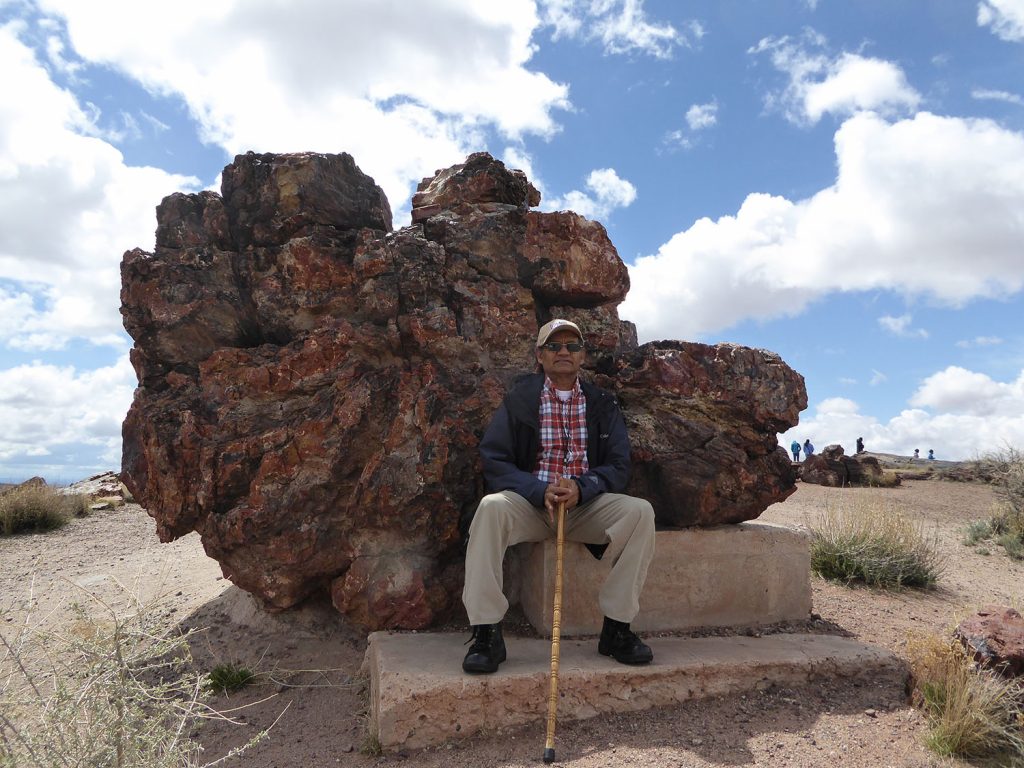New way of teaching
An essay by Dr. Siri Nimal Wickramaratne, Clark College Geography associate adjunct professor
My telephone rang shortly before 8 a.m. on April 6, the first day of spring classes at Clark. Having published the content of my online courses on Clark’s virtual system the previous night, I was up early, eager to see what questions my students had.
Yoga (not her real name) was a Running Start student—a high school student taking college courses. She was nervous about not being able to come to an actual classroom for the Geography course due to the stay-at-home restrictions put in place throughout the state of Washington because of the pandemic.

Dr. Siri Nimal Wickramaratne, a geography associate adjunct professor, has had to adapt his teaching methods during virtual learning including teaching GPS skills online. Photo by Dr. Siri Nimal Wickramaratne
I walked her though Clark’s learning system, making sure she had registered properly and knew where to find all the course materials. I listened as her voice calmed as our conversation progressed. By the time we were finished, she felt comfortable with her responsibilities. Yoga was one of several students who needed extra time and attention to navigate this new way of learning in college.
I am quite familiar with teaching virtually—I have facilitated numerous online courses during my teaching career; however, spring 2020 was different. The main difference was that a fair number of students were high school students like Yoga, who were accustomed to attending all of their classes in the classroom and were skeptical about learning remotely.
Digital maps
An online course is not the same as a face-to-face course. It is not a face-to-face course modified to online delivery. In virtual courses, students must be more independent. I teach Geography where there are certain aspects that I have to demonstrate in person. Take, for example, GPS or maps. For students to grasp the techniques, I have to demonstrate them, then, they take them into their hands to practice the steps. I use hand-held GPS units and have students walk around a part of the campus to record the perimeter. For maps, I teach them to locate selected features on large-scale virtual flight rules (VFR) aeronautical charts based on latitude and longitude using degrees, minutes and seconds.
For the spring quarter, I had to improvise. Instead of my standard techniques, I taught GPS basics online. In the place of physical maps, I referred students to the Clark County Geographical Information System (GIS) Unit so they could play with digital maps. I also taught them how to measure slopes on maps as a substitute to measuring slopes in outdoor field classes.
There is much more to do to improve these remote exercises. I’m brainstorming other ways to enhance the learning experience during this virtual education period.
Meanwhile, back in class
By late afternoon of the first day of class, I had responded to more than 50 students out of 97 in the four sections I was teaching. My head ached and my fingers hurt from typing, but somehow I managed to answer all of their questions. The next few days were a blur of back-and-forth questions about registration, students checking in and posting their bios before responding to posts from their classmates.
Then came the hardest part of all. The Geography department has been using a digital version of our textbook since the fall. Students use a software platform called Canvas to read the so-called e-text, get their assignments and respond to their classmates.
Nearly every one of my students had some type of problem with the e-text or the assignments on Canvas. I spent hours explaining to each of them individually, even posting screenshots.
To complicate matters, I had four course sections covering three different subjects within Geography. There was a textbook for each subject, which meant students had difficulties with each of the three textbooks.
Prepare to be challenged
Vera (not her real name) registered late for one of my courses and needed a lot of extra support. However, in the end, there was disappointment.
After I successfully helped her through the initial introductory steps of the course, she was to take the first quiz and interactive e-text assignment.
She said, “This is my first quarter at college, and I was reading the notes not knowing that everything had to be in MyLab. I also do not understand how to use my MyLab. I followed all the instructions…”
I wrote to her that there is no need to worry because there is a first time for everything that we do. I even reset the assignments to give her extended time. Despite all that, she dropped the course the next day.
This was frustrating for me. After giving her extra help, she was not willing to stay enrolled. The experience left me wondering if I could have encouraged Vera to stay in the class using facial expressions, body language and other advantages that being in-person provides.
The lesson for me during this strange time is that college students must act more independently and be prepared to be challenged for the academic rigor.
Vera’s situation reminds me of the Japanese proverb “Anzuru yori umu ga yasushi” which translates, “childbirth is easier than worrying about it.” This means that fear is greater than the danger, or that, often, things are easier than expected. Nevertheless, there are no shortcuts to hard work. Having done my doctorate work in Japan, I often find myself reflecting on proverbs.
There were many bright spots during the spring quarter too. Mariana (not her real name) had been laid off from work and didn’t have the money to purchase the e-text. She had fallen behind when she contacted me to tell me that she had not received her financial aid. It took me some time to convince her to stay in the class. There was a trial version of the textbook available in Clark’s bookstore, which she could access until her financial aid arrived. I also told her about emergency grant opportunities and the Penguin Pantry where she could pick up food boxes. Within a few days, she was back on track. I also gave her extra time to complete the work she missed.
My reflections
I nearly needed psychological first aid at the beginning of the quarter. However, with the commendable support from my colleagues and Clark’s staff, by the third week of class things were smooth and stable.
As the quarter neared its end, 94 students (of the original 97 enrolled) remained in my courses, and 44 of them got an A and four received A-minus. The As amounted to 46.8% of the class grades.
Students like Yoga and Mariana had done it. They overcame the obstacles to complete their path forward. I was thankful for the teamwork. I could hardly contain my tears of joy as I recalled the cooperation of faculty and staff as we navigated the first fully online term of this unprecedented time of crisis.
The above-mentioned Japanese proverb is worth repeating: “Anzuru yori umu ga yasushi.” It reminds me of the joy and relief I felt at the end of this historic quarter.



